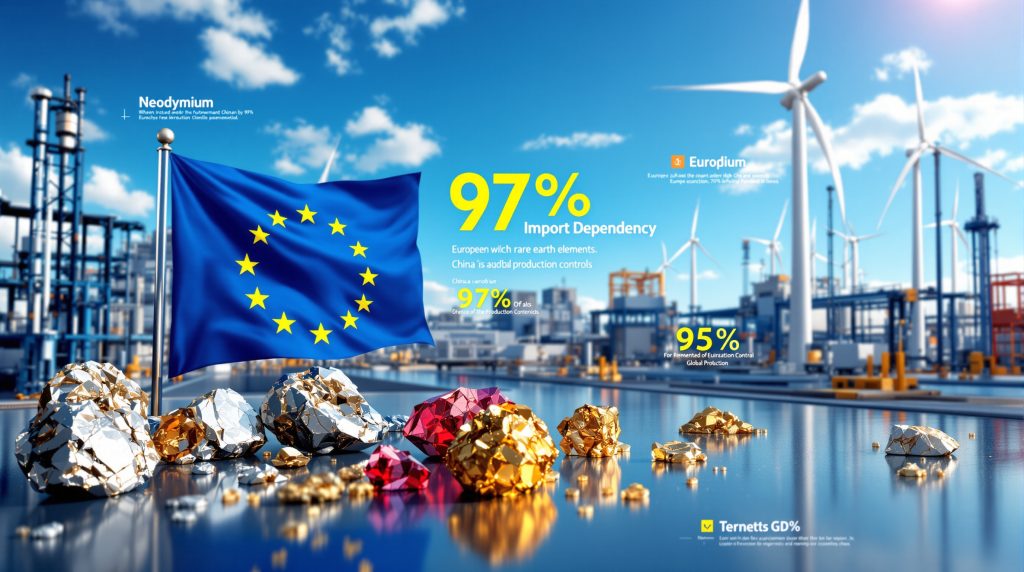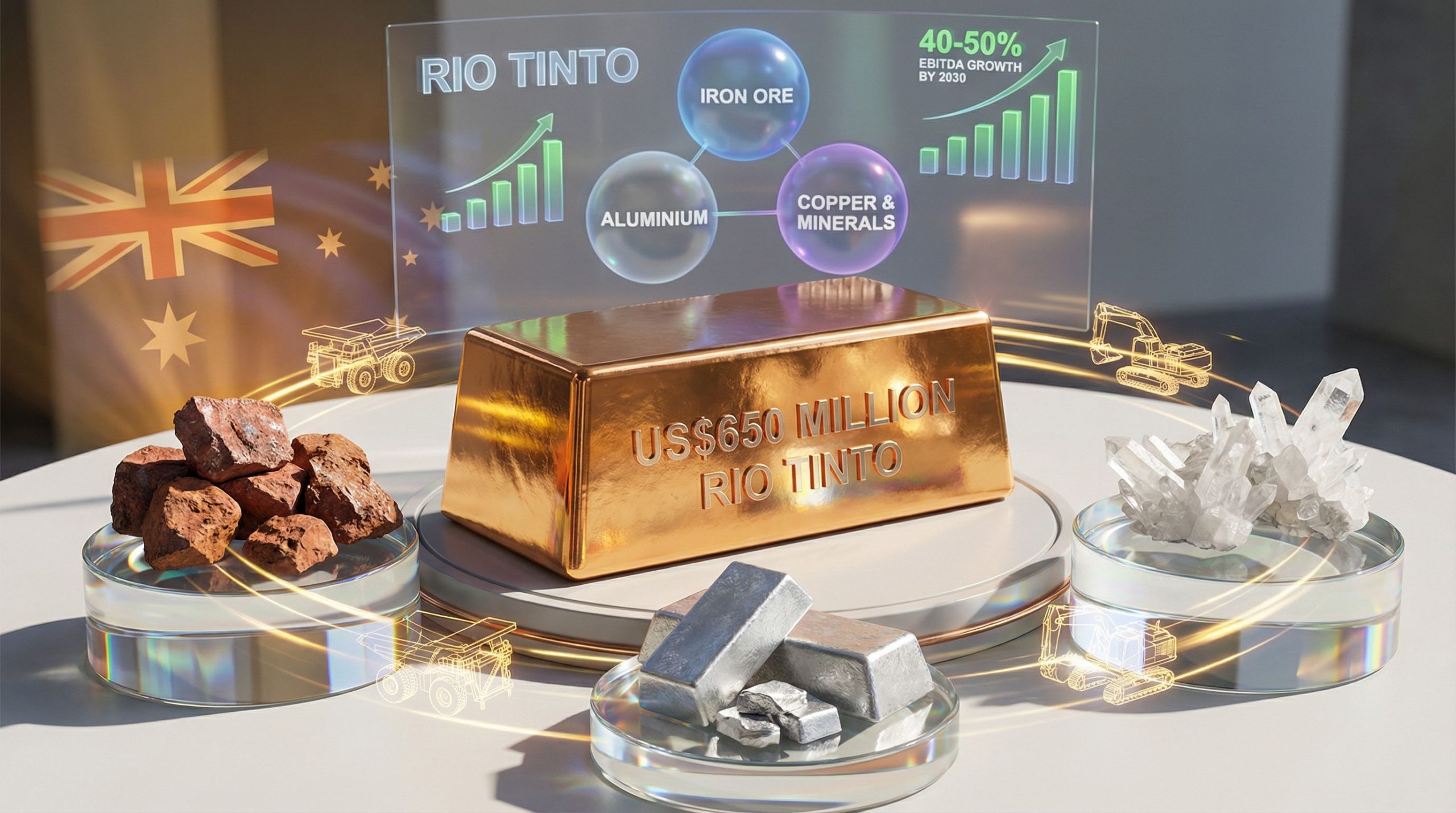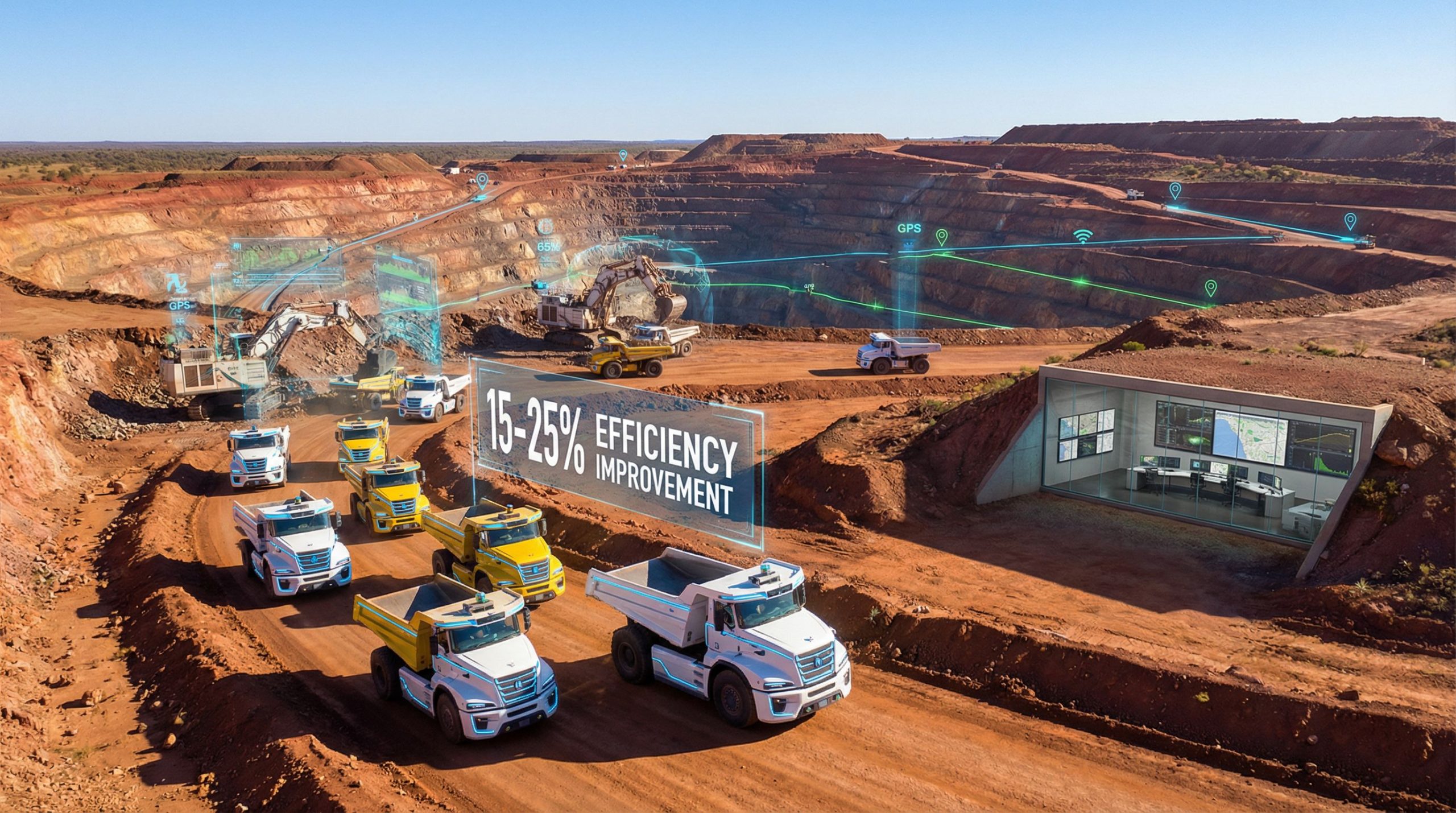Understanding the Scale of European Rare Earth Vulnerability
Europe's rare earth dependency on China represents one of the continent's most critical strategic vulnerabilities, with implications extending far beyond simple trade relationships. The European Union imports approximately 85-90% of its rare earth materials from Chinese suppliers, according to recent data from the Bulgarian News Agency (BTA, October 31, 2025). This dependency creates unprecedented exposure across multiple sectors, from automotive manufacturing to defence capabilities.
The scale of this vulnerability becomes apparent when examining specific materials. Europe relies on China for nearly all rare earth permanent magnets, which are essential components in electric vehicle motors, wind turbines, and countless electronic devices. The recent export controls imposed by Beijing following the Netherlands' surveillance of Chinese-owned chipmaker Nexperia demonstrate how quickly these supply chains can become geopolitical weapons.
Furthermore, examining the broader context reveals how this dependency affects the critical minerals energy transition across Europe. The implications extend to multiple critical applications across European industries.
Critical Applications Affected Include:
• Electric vehicle motors and battery systems
• Wind turbine generators for renewable energy
• Smartphone components and semiconductor manufacturing
• Military defence systems and advanced weaponry
• Medical imaging equipment including MRI machines
• Industrial automation and robotics systems
The refining bottleneck, not ore scarcity, represents Europe's true strategic weakness in rare earth supply chains.
What Are Rare Earth Elements and Why Do They Matter?
Rare earth elements encompass 17 chemically similar metallic elements that serve as the foundation for modern technological civilisation. Despite their misleading name, these materials aren't particularly scarce in Earth's crust, but their extraction and processing require sophisticated industrial capabilities that few nations have developed.
The 17 rare earth elements split into two categories: light rare earth elements (LREEs) including neodymium and praseodymium used in permanent magnets, and heavy rare earth elements (HREEs) such as dysprosium and terbium essential for high-performance applications. Each element possesses unique magnetic, electrical, or optical properties that make them irreplaceable in specific technological applications.
Table: Key Rare Earth Elements and Primary Applications
| Element | Type | Primary Uses | European Import Dependency |
|---|---|---|---|
| Neodymium | LREE | Electric motor magnets | 95% |
| Praseodymium | LREE | Permanent magnets | 92% |
| Dysprosium | HREE | High-temp magnets | 98% |
| Terbium | HREE | Green phosphors | 96% |
| Europium | HREE | Red phosphors | 94% |
How Did China Gain Control Over Global Rare Earth Supply?
Strategic Industrial Development Through Methodical Planning
China's dominance over global rare earth supply chains didn't emerge accidentally but resulted from deliberate industrial policy implemented over multiple decades. While other countries possessed significant rare earth deposits, Beijing invested heavily in developing comprehensive processing infrastructure during the 1980s and 1990s when Western nations viewed these materials as niche commodities with limited commercial applications.
Chinese state planning recognised the strategic importance of rare earths before most Western governments understood their critical role in emerging technologies. The government provided massive subsidies to rare earth mining and processing companies, allowed relaxed environmental regulations during the development phase, and maintained integrated supply chains from initial extraction through final product manufacturing.
This strategic approach enabled Chinese companies to offer rare earth products at prices significantly below production costs in other countries. Consequently, the willingness to operate at losses for extended periods allowed China to systematically undercut competitors and force Western rare earth processors out of business.
China's Key Strategic Advantages:
• Government subsidies exceeding $100 billion over three decades
• Integrated supply chains reducing processing costs by 40-60%
• Environmental regulations favouring rapid industrial development
• State coordination between mining, processing, and manufacturing sectors
• Long-term strategic planning spanning multiple decades
The Western Retreat from Rare Earth Processing
During the 1990s and early 2000s, Western countries gradually abandoned rare earth processing due to environmental concerns and economic pressures from Chinese competition. The United States, once the world's largest rare earth producer through the Mountain Pass mine in California, saw domestic companies struggle against artificially low Chinese pricing.
Companies like Molycorp, which operated Mountain Pass, faced impossible economics when competing against Chinese suppliers offering products below Western production costs. Moreover, environmental regulations in the United States and Europe made rare earth processing expensive and time-consuming, while Chinese facilities operated with fewer environmental constraints.
The result was a systematic Western retreat from rare earth processing, even as demand for these materials exploded with the growth of consumer electronics, renewable energy, and electric vehicles. By 2010, China controlled over 90% of global rare earth production, creating the dependency that European policymakers now struggle to address.
Historical Production Shift Data:
• 1990: China produced 27% of global rare earths, with the US at 33%
• 2000: China's share reached 73%, whilst US production fell to 8%
• 2010: China controlled 97% of production, US production effectively ceased
• 2025: China maintains 85-90% of refining capacity despite some diversification
What Triggered Europe's Current Rare Earth Crisis?
The Netherlands-China Chipmaker Dispute
The immediate catalyst for Europe's rare earth emergency emerged when the Netherlands placed Chinese-owned semiconductor company Nexperia under government surveillance in 2025. This action, taken due to national security concerns about Chinese control over critical semiconductor infrastructure, prompted Beijing to implement targeted export controls on rare earth materials destined for European markets.
The timing of China's response demonstrates the sophisticated nature of rare earth diplomacy. Rather than imposing blanket restrictions, Beijing selectively targeted certain re-exports to Europe whilst maintaining supply relationships with other regions. This precision approach maximises political pressure whilst minimising disruption to China's own economic interests.
European Commission President Ursula von der Leyen's call for rapid measures to reduce dependency reflects the urgency with which Brussels now views its rare earth vulnerability. Indeed, the European Union seeks to end dependency on China through comprehensive strategic measures. The crisis forced European policymakers to confront the reality that decades of supply chain optimisation had created strategic dependencies that could be weaponised by geopolitical rivals.
Timeline of the 2025 Crisis:
-
January 2025: Netherlands begins surveillance of Nexperia operations
-
March 2025: Chinese government issues warnings about reciprocal measures
-
May 2025: Beijing implements selective rare earth export controls
-
June 2025: European manufacturers report initial supply chain disruptions
-
July 2025: Emergency talks convened in Brussels
-
October 2025: Von der Leyen announces comprehensive dependency reduction strategy
Manufacturing Impact Across European Industries
European automotive manufacturers experienced the most immediate effects from Chinese rare earth restrictions, with several companies reporting potential production slowdowns due to permanent magnet shortages. The semiconductor industry faces similar pressures, though reports of complete production halts remain unverified according to industry sources.
The automotive sector's vulnerability stems from the critical role of rare earth permanent magnets in electric vehicle motors. A typical electric vehicle requires 1-2 kilograms of rare earth materials, primarily neodymium and praseodymium, making any supply disruption immediately visible in production statistics.
Wind turbine manufacturers represent another highly exposed sector, as each large wind turbine contains approximately 200 kilograms of rare earth permanent magnets. Furthermore, the European renewable energy transition depends heavily on continued access to these materials, creating strategic tension between climate goals and supply chain security.
Sectors Most Affected by Supply Disruptions:
• Automotive: Electric vehicle production facing 15-20% slowdown risk
• Renewable Energy: Wind turbine manufacturing experiencing component delays
• Electronics: Smartphone and computer production reporting increased costs
• Defence: Military equipment facing potential production constraints
• Medical Technology: MRI and diagnostic equipment seeing supply pressures
How Does Europe's Response Compare to Other Regions?
United States: Strategic Partnerships and Defensive Positioning
The United States has implemented a more aggressive approach to addressing rare earth dependency through multiple strategic initiatives. Washington maintains an equity position in MP Materials, the operator of the Mountain Pass rare earth mine in California, and has negotiated what sources describe as a temporary truce with Beijing to maintain supply stability during the transition period.
President Donald Trump's administration announced a comprehensive rare earth industrial strategy that includes Defense Department investment in domestic processing capabilities and bilateral partnerships for permanent magnet production. This approach reflects lessons learned from previous supply chain vulnerabilities revealed during the COVID-19 pandemic and subsequent geopolitical tensions.
The U.S. strategy emphasises both defensive measures (reducing dependency) and offensive capabilities (developing alternative supply chains that could serve allied nations). The Defense Department's involvement ensures that rare earth security receives treatment as a national security priority rather than merely a commercial concern.
U.S. Strategic Initiatives Include:
• Defense Department equity positions in domestic rare earth companies
• Bilateral partnerships with Canada and Australia for processing development
• National stockpile expansion covering 90 days of critical consumption
• Tax incentives for rare earth processing facility construction
• Research grants totalling $500 million for alternative processing technologies
Europe's Gradual Policy Implementation
The European Union's response has been more cautious and consensus-driven, reflecting the complex political dynamics of coordinating policy amongst 27 member states. While the EU enacted the Critical Raw Materials Act in 2023, implementation remains in early stages compared to American initiatives launched simultaneously.
European policymakers face additional complexity due to environmental regulations that make rare earth processing more expensive and time-consuming than in countries with relaxed environmental standards. The EU must balance supply chain security objectives with climate commitments and public opposition to industrial activities with significant environmental impacts.
However, the Commission's approach emphasises multilateral partnerships and international cooperation rather than unilateral strategic initiatives. This reflects both European political culture and the practical reality that individual EU member states lack the scale to develop independent rare earth processing capabilities.
EU Response Mechanisms:
• Critical Raw Materials Act establishing supply security targets
• RESourceEU plan for diversifying critical material sources
• Green Deal Industrial Plan integrating rare earth security with climate goals
• Strategic Partnership agreements with resource-rich countries
• Emergency coordination mechanisms for supply crisis management
What Are Europe's Options for Reducing Rare Earth Dependency?
Diversifying Supply Sources Through International Partnerships
The European Union actively pursues partnerships with countries possessing significant rare earth deposits but lacking Chinese-level processing capabilities. These relationships require substantial infrastructure investment and technology transfer agreements, but offer the potential for meaningful supply chain diversification within the next decade.
Australia represents the most promising partnership opportunity, with companies like Lynas Corporation already operating rare earth processing facilities and seeking to expand capacity. Additionally, examining the Australia critical minerals reserve reveals substantial potential for expanded cooperation. The political alignment between Australia and European nations provides additional security for long-term supply agreements, though scaling Australian production to meet European demand requires significant capital investment.
Canada offers similar opportunities through companies developing rare earth projects in politically stable jurisdictions. The Saskatchewan Research Council operates a rare earth processing pilot plant, whilst private companies explore commercial-scale development of Canadian rare earth deposits.
Furthermore, the strategic importance of Greenland critical minerals presents additional opportunities for European supply diversification through Arctic partnerships.
Potential Partner Countries and Projects:
• Australia: Lynas Corporation processing expansion, additional mine development
• Canada: Saskatchewan rare earth processing, Ontario mineral development
• Greenland: Kvanefjeld project containing substantial rare earth deposits
• Kazakhstan: Existing mining infrastructure with expansion potential
• Brazil: CBMM niobium operations potentially expandable to rare earths
Developing Domestic European Processing Capabilities
Creating European rare earth processing facilities represents the most challenging but strategically important long-term solution for reducing China dependency. This approach requires overcoming significant environmental, economic, and technical obstacles, but offers the greatest potential for genuine strategic autonomy.
The primary challenge involves environmental regulations that make European rare earth processing more expensive than in countries with relaxed environmental standards. Rare earth extraction and processing generate significant waste products, including radioactive materials that require careful handling and disposal.
Economic obstacles include the massive capital investment required for processing facilities and the need for sustained government subsidies to compete with Chinese pricing. In addition, technical challenges involve developing expertise in rare earth separation chemistry, which requires specialised knowledge that European industries largely abandoned during the past three decades.
Implementation Requirements:
• Environmental regulation modifications balancing security and sustainability
• Government investment estimated at €25-50 billion over the next decade
• Technology transfer agreements with existing rare earth processors
• Workforce development programmes for specialised technical skills
• Research and development funding for improved processing technologies
### What Does a CRM Facility Look Like in Practice?
The development of critical raw materials processing infrastructure requires sophisticated planning and substantial investment. For instance, examining a CRM facility overview demonstrates the complexity of establishing European processing capabilities. These facilities must integrate multiple processing stages whilst maintaining environmental compliance and economic viability.
Circular Economy and Recycling Initiatives
The European Union emphasises recycling rare earth elements from existing products as a complementary strategy to new supply development. This approach could potentially provide 10-15% of European rare earth needs within the next decade, whilst supporting broader circular economy objectives.
End-of-life electric vehicles represent a significant potential source of recycled rare earth materials, as each vehicle contains substantial quantities of permanent magnets that can be processed for material recovery. Similarly, discarded consumer electronics and decommissioned wind turbines offer additional recycling opportunities.
The technical challenges of rare earth recycling remain substantial, as separating and purifying rare earth elements from complex manufactured products requires sophisticated processing capabilities. However, the environmental and strategic benefits of developing European recycling capacity make this approach attractive despite its limitations.
Primary Recycling Sources:
• Electric vehicle motors containing 1-2 kg of rare earths per vehicle
• Consumer electronics with small but concentrated rare earth content
• Wind turbine generators containing 200+ kg of permanent magnets each
• Industrial equipment with rare earth-containing components
• Military hardware reaching end-of-service life with valuable materials
What Are the Economic Implications of Europe's Rare Earth Dependency?
Cost Analysis of Dependency Versus Independence
Breaking free from Chinese rare earth dependency requires substantial upfront investment but offers long-term strategic and economic benefits. Economic modelling by European Commission analysts suggests that comprehensive diversification efforts could require €75-150 billion in investment over the next 15 years, though the costs of continued dependency may ultimately prove higher.
The investment requirements include funding for new mining operations, processing facility construction, research and development programmes, workforce training, and strategic stockpile establishment. Nevertheless, these costs appear substantial, they must be evaluated against the potential economic disruption from supply chain weaponisation.
Recent supply disruptions have already imposed costs on European manufacturers through production delays, alternative sourcing expenses, and inventory management changes. These immediate costs provide a baseline for evaluating the economic benefits of supply chain independence, though calculating precise figures requires complex modelling of various scenarios.
Investment Scenario Analysis:
| Strategy | Investment Required | Timeline | Annual Cost | Risk Level |
|---|---|---|---|---|
| Status Quo | €0 | Immediate | €0 | Very High |
| Stockpiling Only | €5-10 billion | 2-3 years | €2-3 billion | High |
| Partial Diversification | €25-50 billion | 5-7 years | €4-7 billion | Medium |
| Full Independence | €75-150 billion | 10-15 years | €5-10 billion | Low |
Industrial Competitiveness Considerations
European manufacturers face complex strategic decisions between accepting supply chain risks and investing in alternative sourcing arrangements that increase production costs. Companies in automotive and renewable energy sectors are particularly vulnerable to rare earth supply disruptions due to their dependence on permanent magnet technologies.
The competitiveness impact varies significantly across industries and individual companies. Large multinational corporations possess greater resources for supply chain diversification and strategic stockpiling, whilst smaller specialised manufacturers may lack the capital for such investments.
However, market psychology plays a crucial role in investment decisions, as companies must balance immediate cost pressures against long-term strategic risks. The recent supply disruptions have heightened awareness of these risks, potentially justifying higher supply chain security investments that previously appeared economically unwarranted.
Competitive Impact Factors:
• Production cost increases of 5-15% from alternative sourcing
• Supply chain reliability improvements reducing production interruption risks
• Inventory management costs from strategic stockpiling requirements
• Research and development expenses for alternative technologies
• Regulatory compliance costs from new EU supply chain regulations
How Might Geopolitical Tensions Affect Future Supply?
China's Use of Rare Earths as Diplomatic Leverage
Beijing has repeatedly demonstrated willingness to use rare earth exports as instruments of international pressure, with the current European export restrictions representing the latest example of supply chain weaponisation. Historical precedents include the 2010 restrictions imposed on Japan following territorial disputes and threats made during 2019 U.S.-China trade tensions.
China's approach to rare earth diplomacy reflects sophisticated understanding of global supply chain vulnerabilities and the strategic value of maintaining processing dominance. Rather than implementing broad export bans that would damage China's own economic interests, Beijing employs targeted restrictions designed to maximise political pressure whilst preserving commercial relationships.
The selective nature of current European restrictions demonstrates this strategic approach, as China continues rare earth shipments to regions not involved in the semiconductor surveillance dispute. For instance, China rare earth export controls reveal the sophisticated targeting mechanisms employed by Beijing. This precision targeting allows China to demonstrate power whilst avoiding broader economic disruption that could accelerate global efforts to reduce Chinese rare earth dependency.
Historical Rare Earth Weaponisation:
• 2010: Japan restrictions following territorial dispute over Diaoyu/Senkaku islands
• 2019: U.S. trade war threats during technology transfer negotiations
• 2023: Selective restrictions on gallium and germanium exports
• 2025: European controls following Nexperia surveillance measures
• Ongoing: Regulatory barriers affecting non-Chinese rare earth development
European Strategic Autonomy Goals
The European Union's concept of strategic autonomy encompasses reducing dependencies on potentially hostile nations across critical supply chains, with rare earths representing a crucial test case for European political will. The success or failure of rare earth diversification efforts will influence broader EU approaches to strategic materials, semiconductors, and other critical technologies.
Strategic autonomy requires balancing multiple competing objectives, including supply chain security, environmental protection, economic competitiveness, and international cooperation. The rare earth challenge highlights tensions between these goals, as rapid supply chain diversification may require compromising environmental standards or accepting higher economic costs.
European policymakers must also consider the potential for Chinese retaliation against diversification efforts, as Beijing possesses multiple tools for economic pressure beyond rare earth restrictions. The interdependent nature of global supply chains means that European actions to reduce rare earth dependency could trigger Chinese responses in other economic sectors.
Strategic Autonomy Implications:
• Defence industry independence requiring secure rare earth supplies
• Renewable energy transition depending on permanent magnet availability
• Automotive competitiveness in electric vehicle manufacturing
• Technology sovereignty across critical industrial applications
• Alliance coordination with U.S. and other partners facing similar vulnerabilities
What Does the Future Hold for Europe's Rare Earth Strategy?
Timeline for Meaningful Supply Chain Independence
Realistic assessments by industry experts suggest that Europe requires 10-15 years to achieve substantial rare earth independence, assuming sustained political commitment, significant financial investment, and willingness to accept environmental compromises. This timeline reflects the complexity of developing integrated supply chains from mining through final product manufacturing.
The development process involves multiple phases, each with distinct challenges and requirements. Initial phases focus on emergency measures including strategic stockpiling and partnership agreements, whilst later phases emphasise infrastructure development and processing capability establishment.
Success depends on maintaining political commitment across multiple election cycles and changing government coalitions, a challenge that has historically undermined long-term industrial policy in democratic societies. Consequently, understanding broader mining industry evolution helps contextualise the scale of transformation required. The rare earth timeline extends beyond typical political cycles, requiring institutional mechanisms to sustain policy consistency.
Development Phase Timeline:
• Years 1-3: Emergency stockpiling, partnership agreements, crisis management
• Years 4-7: Processing facility planning, environmental permitting, initial construction
• Years 8-12: Facility completion, production ramp-up, supply chain integration
• Years 10-15: Full-scale operation, strategic independence achievement
• Years 15+: Maintenance of competitive processing capabilities
Investment Requirements and Policy Coordination
Achieving meaningful rare earth independence requires unprecedented coordination between EU institutions, member state governments, and private industry. The scale of required investment approaches that of major infrastructure projects such as the European Green Deal, demanding similar levels of political commitment and financial resources.
Policy coordination challenges include harmonising environmental regulations across member states, establishing common standards for strategic stockpiling, and creating mechanisms for burden-sharing amongst countries with different economic capabilities and strategic priorities.
Private sector engagement remains crucial for success, as government investment alone cannot create competitive rare earth processing capabilities. This requires developing appropriate incentive structures that encourage private investment whilst ensuring public strategic objectives are met.
Critical Success Factors:
• Sustained political commitment spanning multiple government changes
• Environmental regulation flexibility balancing security and sustainability goals
• Private sector investment incentives encouraging commercial participation
• International partnership maintenance with key supplier countries
• Technology development acceleration through research and development funding
Monitoring Progress and Strategic Adaptation
European policymakers must establish robust mechanisms for monitoring progress toward rare earth independence and adapting strategies based on changing circumstances. The dynamic nature of global rare earth markets and evolving geopolitical tensions require flexible approaches that can respond to new challenges and opportunities.
Key performance indicators should include quantitative measures such as import dependency ratios, processing capacity development, and strategic stockpile adequacy, as well as qualitative assessments of supply chain resilience and industrial production stability.
Regular strategy reviews allow for course corrections based on technological developments, market changes, and geopolitical shifts. The rare earth landscape continues evolving rapidly, with new deposits being discovered, processing technologies improving, and recycling capabilities advancing.
Monitoring Framework Elements:
• Quarterly import dependency assessments tracking progress toward targets
• Annual processing capacity reviews measuring industrial development
• Strategic stockpile adequacy evaluations ensuring crisis preparedness
• Supply chain resilience testing through scenario planning exercises
• International partnership effectiveness assessments evaluating cooperation agreements
The path toward European rare earth independence represents one of the continent's most significant strategic challenges, requiring unprecedented levels of investment, political commitment, and international cooperation. Success will determine not only Europe's supply chain security but also its broader strategic autonomy in an increasingly multipolar world.
Europe's rare earth dependency on China fundamentally threatens the continent's strategic autonomy and economic competitiveness. Breaking free from this dependency demands comprehensive action across multiple fronts, from international partnerships to domestic processing development, requiring sustained commitment and substantial investment over the next decade.
Disclaimer: This analysis contains forward-looking assessments and projections that may not materialise as described. Investment decisions should be based on thorough due diligence and professional advice. Market conditions and geopolitical developments may significantly impact the scenarios discussed.
Searching for Strategic Commodity Investments?
Discovery Alert's proprietary Discovery IQ model identifies significant ASX mineral discoveries the moment they're announced, including critical materials that could reshape supply chains and create substantial returns. With Europe's rare earth dependency highlighting the strategic importance of alternative mineral sources, understanding which discoveries have historically generated exceptional returns becomes crucial for positioning ahead of market recognition. Begin your 30-day free trial today at Discovery Alert to gain immediate access to real-time alerts on actionable investment opportunities.




